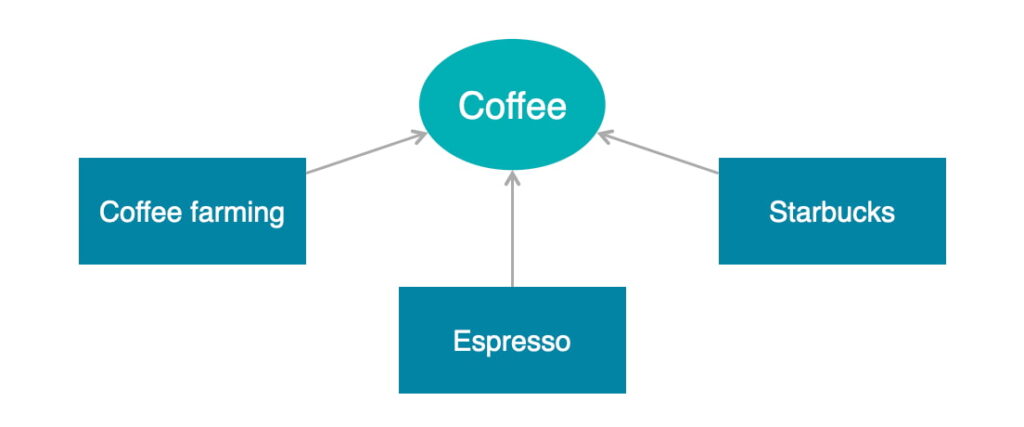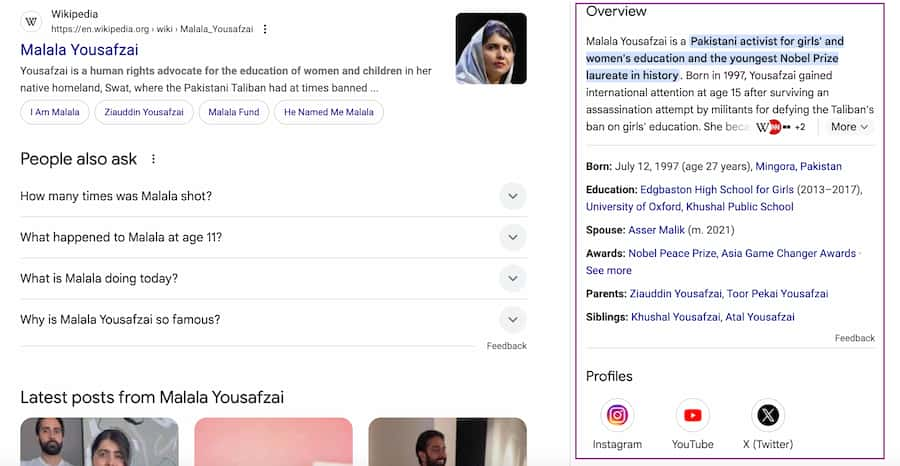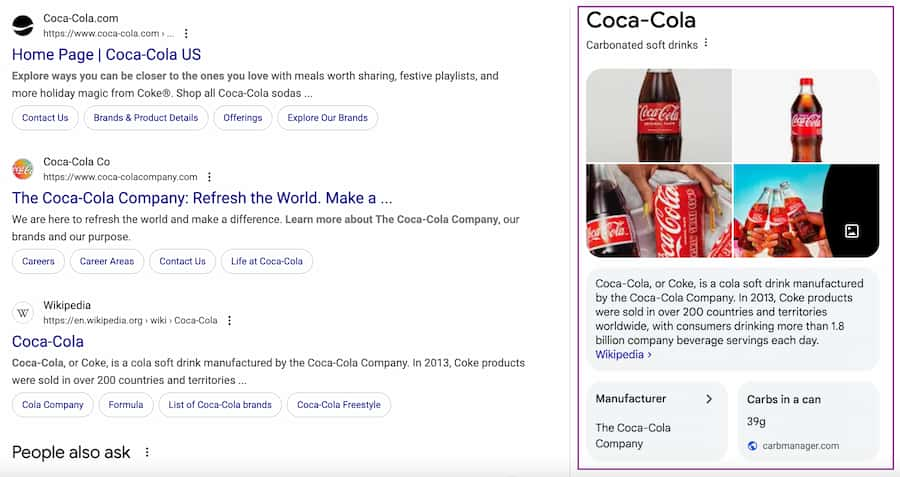Knowledge Graph vs. Knowledge Panel: Key Differences Explained
The Knowledge Graph and Knowledge Panel are two distinct yet related things.

You’ve probably Googled something and noticed a neatly packaged box of information right in the search results—a handy summary of a celebrity, company, or historical event. It feels like Google anticipated exactly what you wanted to know. What’s not so obvious is that this tidy display is made possible by two different but connected systems: the Knowledge Graph working quietly in the background, and the Knowledge Panel sitting front-and-center, presenting curated information clearly. In both SEO and reputation management, the Knowledge Panel is important.
If your work involves managing your brand’s online presence and reputation, understanding how these two tools differ—and how they interact—is imperative. The Knowledge Graph is Google’s structured database of interconnected facts about entities, while the Knowledge Panel is the visual summary that showcases these facts directly to users. Knowing the dynamics between them helps you understand how Google processes information about your brand and, more importantly, how you can shape that information.
This article will clarify the fundamental differences between Google’s Knowledge Graph and Knowledge Panel, helping you strategically manage your brand’s visibility online.
Key Takeaways
Knowledge Graph vs. Knowledge Panel: The Knowledge Graph is Google’s behind-the-scenes network of interconnected data, while the Knowledge Panel is the curated visual representation you see in search results.
Behind-the-Scenes Power: Google’s Knowledge Graph organizes data by understanding the relationships between entities rather than just isolated keywords.
Visual Front Door: The Knowledge Panel offers users a snapshot of important details about your brand, affecting first impressions and fostering trust.
Influence Potential: Although you can’t directly control the Knowledge Graph, you can influence what’s presented through accurate and consistent source data. With the Knowledge Panel, you can directly suggest edits and updates.
Interconnected Strategies: Understanding the distinct roles of these two systems provides a competitive advantage when building your online presence and reputation.
Now, let’s break down exactly how the Knowledge Graph and Knowledge Panel function separately, yet work hand-in-hand to shape your brand’s online perception.
What is a Knowledge Graph?
Definition and Overview
Google’s Knowledge Graph, introduced in 2012, is an enormous database that maps relationships between billions of entities—people, companies, places, products, and more. Instead of just matching keywords, the Knowledge Graph helps Google understand who or what you’re actually searching for.
For example, if you search “Leonardo da Vinci,” the Knowledge Graph recognizes him not just as a famous artist, but it also knows his connections to ideas like the Renaissance, locations such as Italy, other historical figures like Michelangelo, and famous works including the Mona Lisa.
The information pulled by the Knowledge Graph materialized itself into the Knowledge Panel in Google search results:

Key Characteristics of the Knowledge Graph
The true strength of the Knowledge Graph is contextual clarity. By organizing information as clearly defined “entities” instead of mere text strings, it can quickly discern whether you’re searching for “Amazon,” the company, or “Amazon,” the river—the connections create context.
Google gathers this structured data from reliable sources like Wikipedia, Wikidata, and verified public databases. Each entity forms a node connected by relationships called edges. So “coffee,” for example, becomes a node linked to other entities like “espresso,” “Starbucks,” and “coffee farming.” These connections help Google deliver answers that feel intuitive and relevant.

From a practical standpoint, having accurate data about your brand reflected here is key to ensuring your business appears in relevant, contextual search results.
Real-World Examples
For brand managers, the Knowledge Graph is especially valuable when users ask direct, conversational questions like, “Who founded Tesla?” By understanding entity relationships, Google can instantly provide the answer (“Elon Musk and others”) directly in search results—making it a valuable tool that strengthens online visibility.
Similarly, if someone searches “Adidas,” the Knowledge Graph gathers essential details about the company—headquarters, founded date, key products—and puts this information front and center thanks to its structured nature.
In other words, the Knowledge Graph quietly shapes your digital footprint, determining how your brand or entity is associated, seen, and discovered through search.
What is a Knowledge Panel?
The Knowledge Panel is the public-facing product that leverages Google’s behind-the-scenes Knowledge Graph. It’s that neat, informative box that summarizes key details about a person, business, or subject directly in the search page results.
Definition and Overview
When you search a known entity, like “Tesla Inc.” or “Michelle Obama,” you’ll see a Knowledge Panel, often along the right side (or near the top on mobile), displaying critical, easily-digestible facts: logos, names, roles, birthdates, achievements, official links, and recent news.

Unlike the more technical and complex Knowledge Graph, the Knowledge Panel is specifically designed to deliver a high-quality user experience, giving users quick access to accurate and verified information without forcing them to click away from Google.
Key Characteristics of Knowledge Panels
These panels are designed to assemble critical information succinctly and visually. A celebrity panel, for example, usually includes a photo, top credits, personal details, and official social media links. Meanwhile, a business panel can include headquarters locations, key management, recent news, and customer reviews.

The important distinction is transparency—Knowledge Panels clearly credit the original sources, typically websites like Wikipedia or your official site. This not only builds user trust but gives you a pathway to shape the information Google displays, especially if inaccuracies exist.
Practical Applications for Brand Managers
The Knowledge Panel isn’t merely informational—it’s a branding tool in its own right. Executives, managers, and marketing professionals regularly leverage it to enhance reputation and credibility.
For instance, a law firm’s Knowledge Panel might prominently feature contact details, office hours, and online ratings, helping drive incoming leads. Public figures like executives or authors might showcase their latest accomplishments and projects directly through panel updates.
Proactively managing your Knowledge Panel—claiming, verifying, and regularly updating it—is key to positively influencing your brand’s narrative in Google’s highly visible search results.
Key Differences Between the Knowledge Graph and Knowledge Panel
Structural Differences
The fundamental difference boils down to purpose: The Knowledge Graph is the massive connected database that fuels Google’s understanding of entities, while the Knowledge Panel is the curated visual summary showing this information directly to users.
Think of it like city infrastructure: the Knowledge Graph is the intricate web of roads, electricity, and plumbing below ground, essential yet hidden, while the Knowledge Panel is your welcoming storefront, clearly visible and neatly designed.
Functional Differences
The Knowledge Graph plays a foundational role in ensuring search results are relevant and contextually accurate. Its job is translating user intent through relationships between data. If you ask Google about “famous explorers,” the Graph immediately understands it’s looking for related historical figures such as Columbus or Magellan.
The Knowledge Panel, however, focuses on short, summarized information people care most about. A quick look could yield a vast amount of information about your brand or person—location, recent events, management, and more—within seconds.
Customizability and Control Differences
You generally can’t directly alter the Knowledge Graph—it’s algorithmically controlled and data-driven. However, you can indirectly influence it by ensuring consistent and accurate online information across websites, directories, and public databases.
The Knowledge Panel gives you more direct control. Businesses and verified public figures can claim their Knowledge Panels and directly suggest corrections or additions through Google. This proactive management can help brands address outdated, inaccurate, or incomplete information.
Relation to Google Knowledge Panel Management
The Knowledge Graph as Foundation for Panel Creation
Every Knowledge Panel is built from data stored within Google’s Knowledge Graph. Accurate and authoritative source information from reputable websites (such as Wikipedia, official company pages, or online directories) inform the Knowledge Graph, which in turn feeds your public-facing panel.
For instance, let’s say your company expands internationally. By keeping consistent web properties (website, Wikipedia entries, and industry databases updated with your new locations), you seed the Knowledge Graph effectively. Over time, this adjustment can show up clearly in your Knowledge Panel.
Knowledge Panels for Reputation and Brand Strategy
Since Knowledge Panels are highly visible, they’re valuable tools for branding and reputation management. Through Google’s verified claiming process, brands have a real opportunity to shape their online story—updating key factual information, choosing logo placement, and refining contact details.
A practical example: A rebranded small business, after updating their authoritative sources and claiming their Knowledge Panel, ensures consistency of branding rather than letting outdated logos or contact info confuse prospective customers.
Why Understanding Both Matters for Your Online Presence
Boosting SEO and Digital Visibility
Since the Knowledge Graph powers search relevance, you’ll enhance your online visibility if your business information is accurate, detailed, and clearly structured across digital platforms. A cohesive presence in the Graph translates to a robust, effective Knowledge Panel, helping you capture and retain customer attention.
Enhancing Reputation Management Efforts
If your brand’s online presence has inaccuracies within the Knowledge Graph data, you risk misinformation surfacing in your Knowledge Panel—potentially harming your professional reputation and customer trust. Conversely, understanding and actively managing both provides tangible branding and reputation benefits, as demonstrated by brands like Nike that consistently appear credible and authoritative in search.
Conclusion
Your brand’s perception increasingly hinges on Google’s interpretation and presentation of streamlined data. The internet shapes how you’re recognized, understood, and remembered—and that’s exactly why managing the relationship between the Knowledge Graph and Knowledge Panel matters.
By proactively influencing these key structures, you protect your brand’s integrity and improve how you look online—which, as any seasoned executive knows, is valuable currency within today’s search-driven marketplace.
Tags: Knowledge Panel.
